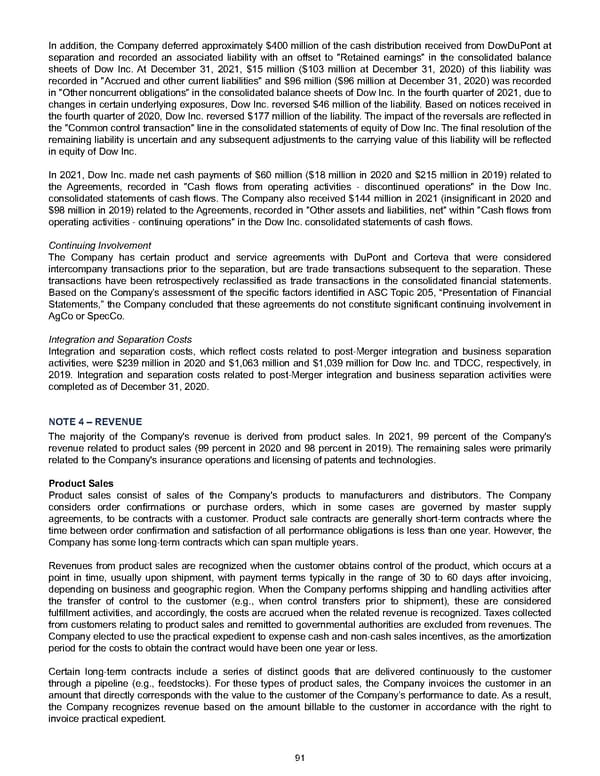In addition, the Company deferred approximately $400 million of the cash distribution received from DowDuPont at separation and recorded an associated liability with an offset to "Retained earnings" in the consolidated balance sheets of Dow Inc. At December 31, 2021 , $15 million ( $103 million at December 31, 2020) of this liability was recorded in "Accrued and other current liabilities" and $96 million ( $96 million at December 31, 2020) was recorded in "Other noncurrent obligations" in the consolidated balance sheets of Dow Inc. In the fourth quarter of 2021, due to changes in certain underlying exposures, Dow Inc. reversed $46 million of the liability. Based on notices received in the fourth quarter of 2020, Dow Inc. reversed $177 million of the liability. The impact of the reversals are reflected in the "Common control transaction" line in the consolidated statements of equity of Dow Inc. The final resolution of the remaining liability is uncertain and any subsequent adjustments to the carrying value of this liability will be reflected in equity of Dow Inc. In 2021 , Dow Inc. made net cash payments of $60 million ( $18 million in 2020 and $215 million in 2019 ) related to the Agreements, recorded in "Cash flows from operating activities - discontinued operations" in the Dow Inc. consolidated statements of cash flows. The Company also received $144 million in 2021 (insignificant in 2020 and $98 million in 2019) related to the Agreements, recorded in "Other assets and liabilities, net" within "Cash flows from operating activities - continuing operations" in the Dow Inc. consolidated statements of cash flows. Continuing Involvement The Company has certain product and service agreements with DuPont and Corteva that were considered intercompany transactions prior to the separation, but are trade transactions subsequent to the separation. These transactions have been retrospectively reclassified as trade transactions in the consolidated financial statements. Based on the Company’s assessment of the specific factors identified in ASC Topic 205, “Presentation of Financial Statements,” the Company concluded that these agreements do not constitute significant continuing involvement in AgCo or SpecCo. Integration and Separation Costs Integration and separation costs, which reflect costs related to post-Merger integration and business separation activities, were $239 million in 2020 and $1,063 million and $1,039 million for Dow Inc. and TDCC, respectively, in 2019 . Integration and separation costs related to post-Merger integration and business separation activities were completed as of December 31, 2020. NOTE 4 – REVENUE The majority of the Company's revenue is derived from product sales. In 2021 , 99 percent of the Company's revenue related to product sales ( 99 percent in 2020 and 98 percent in 2019 ). The remaining sales were primarily related to the Company's insurance operations and licensing of patents and technologies. Product Sales Product sales consist of sales of the Company's products to manufacturers and distributors. The Company considers order confirmations or purchase orders, which in some cases are governed by master supply agreements, to be contracts with a customer. Product sale contracts are generally short-term contracts where the time between order confirmation and satisfaction of all performance obligations is less than one year. However, the Company has some long-term contracts which can span multiple years. Revenues from product sales are recognized when the customer obtains control of the product, which occurs at a point in time, usually upon shipment, with payment terms typically in the range of 30 to 60 days after invoicing, depending on business and geographic region. When the Company performs shipping and handling activities after the transfer of control to the customer (e.g., when control transfers prior to shipment), these are considered fulfillment activities, and accordingly, the costs are accrued when the related revenue is recognized. Taxes collected from customers relating to product sales and remitted to governmental authorities are excluded from revenues. The Company elected to use the practical expedient to expense cash and non-cash sales incentives, as the amortization period for the costs to obtain the contract would have been one year or less. Certain long-term contracts include a series of distinct goods that are delivered continuously to the customer through a pipeline (e.g., feedstocks). For these types of product sales, the Company invoices the customer in an amount that directly corresponds with the value to the customer of the Company’s performance to date. As a result, the Company recognizes revenue based on the amount billable to the customer in accordance with the right to invoice practical expedient. 91
 Annual Report Page 100 Page 102
Annual Report Page 100 Page 102